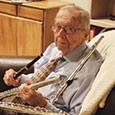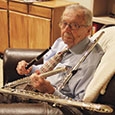During my bonus time I would be eager to learn the Pierre Boulez Sonatine. I have owned that landmark piece for many years. I even have Boulez’s autograph on the title page of my score dating all the way back to 1987. (The Sonatine was commissioned by Jean-Pierre Rampal in 1946, but he never performed it, perhaps because he was not sympathetic to its twelve-tone serialism.) Due to my heavy teaching and performing commitments at Northwestern University and the Chicago Symphony, I never felt that I had enough time to delve into such a difficult piece.
Really? A difficult piece? Not enough time? Well, let’s take another look. I just completed a YouTube survey and found twenty-eight impressive performances of the Boulez Sonatine by both college students and professionals. They certainly did not seem to be fazed by its difficulty or its time demands. So, if they could do it, by golly I can too. (And if Rampal were still alive, I have a hunch he would have finally learned it also.)
Boulez as Conductor
(Recollections of Rehearsing and Performing with Boulez)
Boulez’s debut as guest conductor with the Chicago Symphony was on February 20, 1969, and included on the program was Bartók’s First Piano Concerto with soloist Daniel Barenboim, who was also making his CSO concert debut. Most of the orchestra players still had haunting memories of our performances of that concerto in 1960 with soloist Rudolf Serkin and conductor Fritz Reiner. Reiner had conducted the American premiere of the First Piano Concerto with Bartók himself as soloist with the Cincinnati Symphony in New York’s Carnegie Hall in 1928, apparently with success. But by the late 1950s Reiner had started to lose some of his technical acumen when conducting works that were replete with mixed meters and quick tempo changes – and the first movement of this concerto was highly populated with both. Serkin, who had come to our first rehearsal with the solo part well-prepared and memorized, became frustrated enough at that rehearsal that he resorted to playing from the score at the remaining rehearsals and performances, aided by a very adroit page turner.
But now in 1969, nine years later, we were greatly relieved to find that Boulez not only demonstrated perfect technical control of the rhythmic hurdles of the concerto but that he had worked out a beautifully designed interpretive collaboration with Barenboim. Boulez and Barenboim subsequently developed a long-term close personal and professional friendship until Boulez’s death in 2016. They reprised the Bartók First Piano Concerto with the CSO in 2005. (To fully appreciate the difficulty of this concerto’s first movement I highly recommend that you follow along with the scrolling score on YouTube. Google: Bela Bartók Piano Concerto No. 1. Then select the video panel that displays the music score with the listed timing of 25:15.)
It was not until eighteen years later in 1987 that Boulez returned to Chicago. During that time, he had been music director of the New York Philharmonic (1971-77), chief conductor of the BBC Symphony (1969-77) and founder and director of the newly created Institut de Recherche et Coordination Acoustique/Musique (IRCAM) at the Centre Pompidou in Paris where he also founded the Ensemble Intercontemporain. For his return appearance with the Chicago Symphony, Boulez conducted the Stravinsky Symphonies of Wind Instruments, Bartók’s The Wooden Prince and his own Notations I-IV. After that triumphant return, Boulez guest conducted the CSO annually through 2010. He was named principal guest conductor in 1995.
He was sometimes faulted by critics for being too emotionally detached from the music, and it is true that he never displayed overt histrionics in his conducting demeanor. However, his impeccable knowledge of the score and ever-trustworthy conducting technique brought to us players an extraordinary sense of confidence – and that would certainly count as an indispensable emotion. He conducted without a baton, almost always using both arms in conveying his beat patterns except when giving cues or turning pages. (Boulez never conducted without a score.) The first violin section was especially appreciative of the duality of his conducting pattern, because for them – and depending upon the position of the podium – a conductor’s right arm motions are not always completely discernable.
Incidentally, my first and only appearance as concertmaster of the Chicago Symphony took place on April 30, 1998 when Boulez conducted György Ligeti’s Piano Concerto with Pierre-Laurent Aimard as soloist. The Ligeti concerto accompaniment called for a reduced orchestra consisting of a string quintet, four woodwinds, three brass, and three percussion. Boulez positioned the woodwinds – flute (doubling on piccolo), oboe, clarinet and bassoon – in a semicircle behind and to the left of the piano soloist, with me in the concertmaster position. My sole duty in fulfilling that role was to walk over to the piano and play the tuning A for the orchestra before each rehearsal and concert. From all reports, I apparently did A-OK!
The last time I saw Boulez was on January 9, 2010, almost nine years after my retirement from the CSO. He was conducting the CSO in a concert version of the Bartók opera, Bluebeard’s Castle. Also on the program was Marc-André Dalbavie’s Flute Concerto splendidly performed by Mathieu Dufour, the CSO’s principal flutist. After the concert Boulez, Dufour and I, along with many other members of the orchestra, had a very heartwarming reunion backstage.
Boulez’s last appearance with the CSO was on December 4, 2010. Unfortunately, an eye operation in 2011 left him with severely impaired sight, making it impossible for him to take long transcontinental flights, such as to Chicago. His final conducting appearance was in Salzburg January 28, 2012 with the Vienna Philharmonic, after which he cancelled all remaining conducting engagements. Pierre Boulez died on January 5, 2016 at his home in Baden-Baden, Germany. At the memorial the following day one of the three eulogists was Daniel Barenboim.
* * *
Recordings
Here is a list of those indefatigable flutists and pianists, and I recommend checking them out yourself on YouTube.
Sophie Cherrier, Sebastien Vichard
John Wion, Gilbert Kalish
Felix Renggli, Laetitia Bougnol
Diana Muela Mora, Ioana Mandrescu
Tim Munro, Andrew Hsu
Erich Graf, Douglas Dickson
Yu-Jin Jung, Ji-Hye Suhk
Terence Teow, Hui Zhian Chin
Claire Chase, Jacob Greenberg (start@44:50)
Yi-Hsien Liao, Chuan-Yi Lin
Severino Gazzelloni, Frederic Rzewski (Gazzelloni made three other Boulez CDs)
Laura Faero, Yoko Kimura
Angelo Persichilli, Bruno Canino
Laura Cubides, Kim Sun Joo
Rogier de Pijper, Toon Bierman
Jan van Boterdael, Marcello Mercenier
Mario Caroli, (Uncredited Pianist)
Qiao Zhang, (U.P.)
Sakura Kindynis, (U.P.)
Dionne Jackson, (U.P.)
In addition to the above, there are seven other YouTube performances of the Boulez in which the names of both flutists and pianists are regrettably missing. In one of the best of these unidentified video performances, the flutist stands about five feet behind the pianist apparently reading from the piano score, almost as if playing from memory, and his excellent pianist also proves herself to be a virtuoso page-turner!
There is a Connoisseur Society CD that includes an excellent Boulez performance by Marina Piccinini and Andreas Haefliger. It also has the Prokofiev Sonata and the Jolivet Chant de Linos. Other CDs of the Boulez Sonatine, all of which are available through ArkivMusic include:
Patrick Gallois, Lydia Wong
Philippe Bernold, Alexandre Tharaud
Patricia Spencer, Linda Hall
Barbara Leibundguth (my former student), Carl Witt
(This CD also includes the Nelhybel Suite, Badings Capriccio, Witt Duo, Honegger Romance and Karg-Elert Sinfonische Kanzone
Sophie Cherrier (flute), Sebastien Vichard (piano)
Paula Robison, flute, and Paavali Jumpponen, piano: "Caprice" – Boulez Sonatine and music by Debussy, Lancino and Messiaen.






